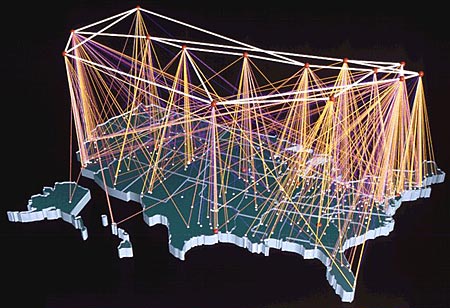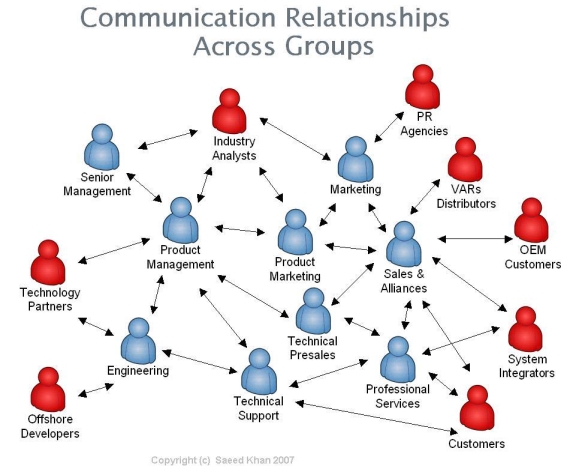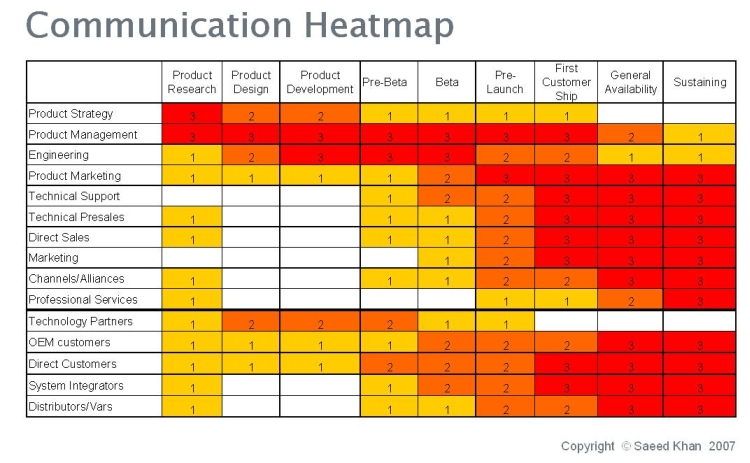Be an integrator, translator and communicator. Don’t be a terminator.
 I’m sure you’ve heard the phrase that Product Managers are “the hub of the wheel”. I really don’t like that line. Who wants to be the hub of any wheel? That’s like saying someone is the hinge of the door or the latch of the hood. Boooring! And not true.
I’m sure you’ve heard the phrase that Product Managers are “the hub of the wheel”. I really don’t like that line. Who wants to be the hub of any wheel? That’s like saying someone is the hinge of the door or the latch of the hood. Boooring! And not true.
Product Managers are collectors, analyzers and dispensers of information. They are routers of information flow. And being a great product manager means understanding how to optimize the information flow so that other teams in your company who are directly or indirectly dependent on you for information get it in a timely manner and in a form they can understand and use.
The following image is a coarse example of the major communication paths that exists in a software company. The blue are internal teams and the red are external.
[click to enlarge]
I say a coarse example, because it really only represents a high-level view of how information flows. Not all links in the diagram contain the same amount of information flow; not all nodes contribute as much information as they receive; and to keep the diagram from becoming cluttered, a number of links that rightfully should be shown are not.
I call these communication pathways the Information Supply Chain. And as a Product Manager, you are directly or indirectly responsible for a lot of the product and technical information that flows throughout your organization. How many times have you been asked if certain functionality is in an upcoming release? Or when a particular release is coming out? Or the details of a beta program? Or whether any pricing or packaging changes are being made to address market needs?
People are asking these questions because they are making decisions and need information to decide wisely. You can have a significant positive impact on those teams if you understand what information people need, when they need it, and in what form they need it? If you can do that for them, they’ll be able to make educated decisions sooner, streamline their work and be more effective. Deliver meager, late or difficult to understand information, and the opposite occurs. There is a real top-line impact to poor information flow in a company.
If you really want be analytic about mapping out the flow, you can do that. You need to look at all the stages of the product development cycle, from conception to completion to launch and beyond, and map out what information different groups need and when they need it. One way to represent it is via a heatmap that may end up looking something like this.
[click to enlarge]
The coloured cells represent areas where communication happens during the development cycle. The deeper the colour, or higher the number (from 1-3 in this case), then the more activity and information flow that happens. As you can see, Product Management is deeply involved in the information flow through all phases of the development cycle, but most heavily early on and in the middle, whereas Marketing and Sales, for example, really start toward the middle and have heavy information flow from the launch stages onward.
By understanding this, you can determine what information you need to produce and deliver to those groups to optimize their activities and decisions. Keep in mind that this is not solely a task for Product Management. Ideally all groups in the company use this analysis to optimize their communications. But, if you want to apply an 80/20 rule (80% impact for 20% effort), then teams like Product Management and Product Marketing must be the first ones to optimize their information flow to other downstream groups.
As technology workers, we exist in an information economy. And just like the manufacturing world, where materials, parts and inventory requirements are optimized for efficiency and minimizing costs, information needs can be understood and delivery processes optimized for greater efficiencies. And because of our role in defining product direction and driving strategy, Product Managers can play a key role in optimizing the Information Supply Chain. The question is, are you up to the task?
Saeed
Part 4 – The 4 Cs of Leadership
Part 6 – Own the product from conception to completion and beyond

